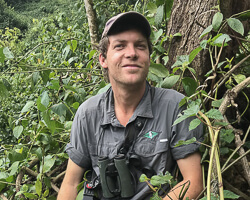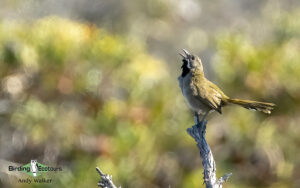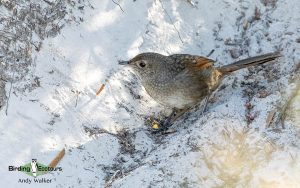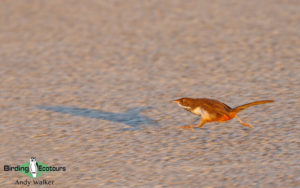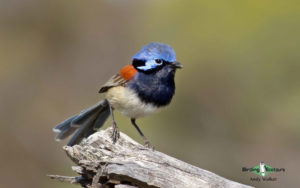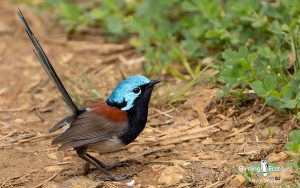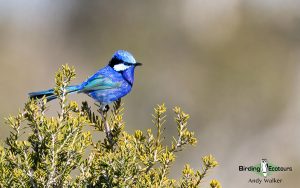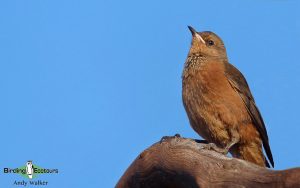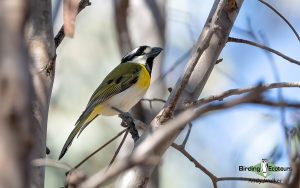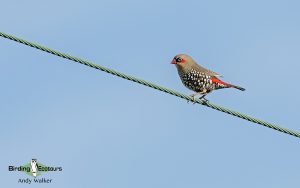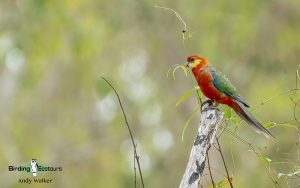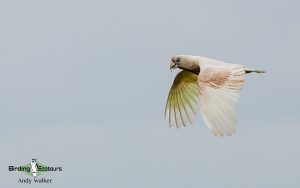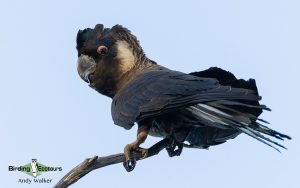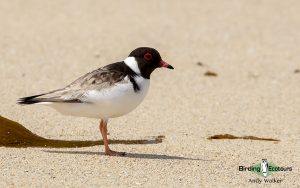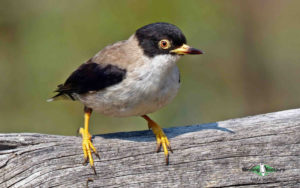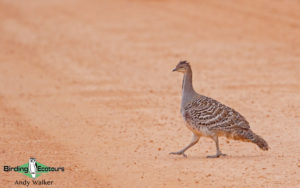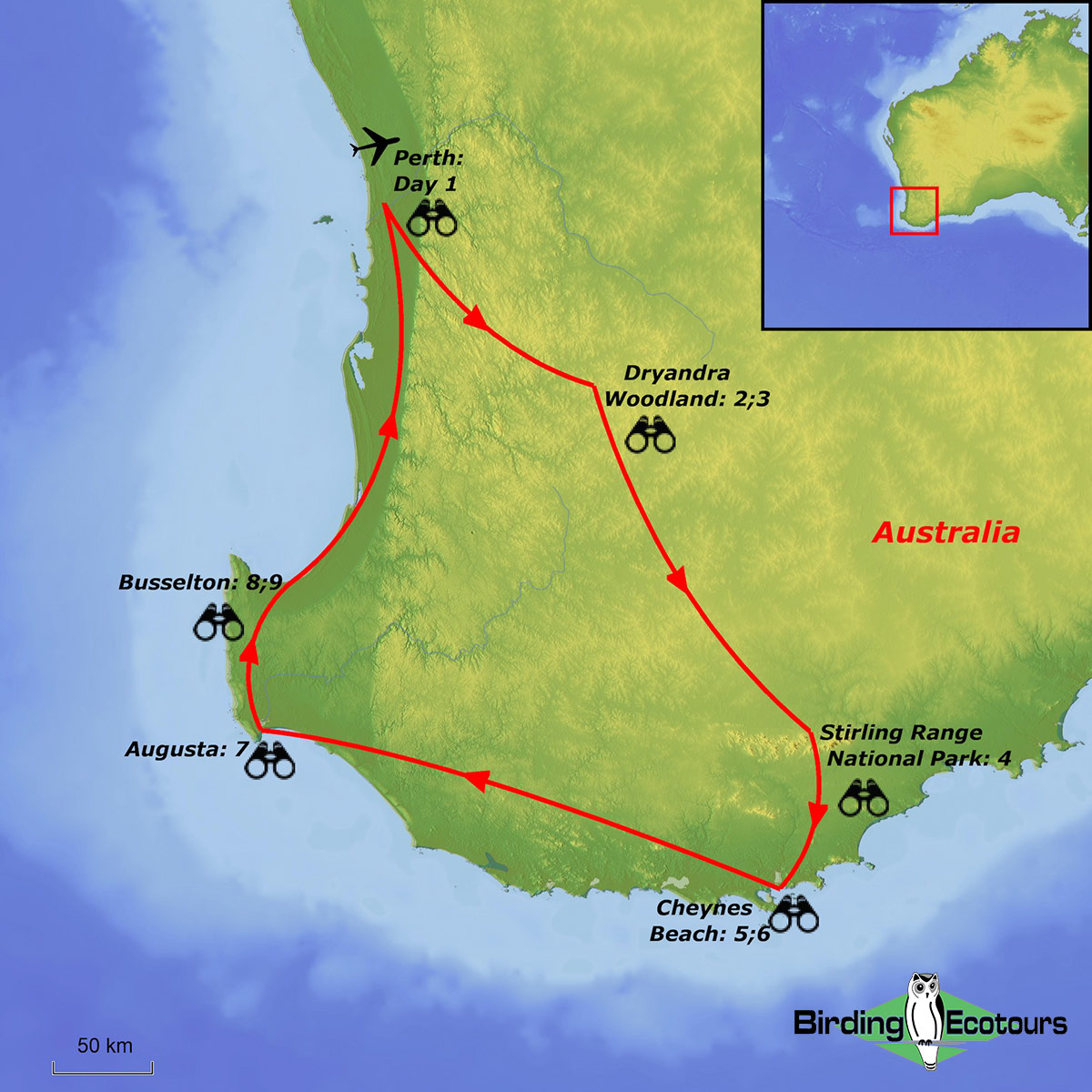Western Australia: Southwest Australian Endemic Birds
Go to: Australia Birding Tours | Birding Tours in Australasia | All our birding tours
Western Australia: Southwest Specialties
September 2025/2026
Due to geographic isolation and diverse habitats, the southwest of the state of Western Australia boasts several endemic species and subspecies. This nine-day small-group well-paced Australian birding tour will focus on finding as many of these Western Australian endemic birds as possible, while also enjoying a wide range of other interesting flora and fauna along the way.
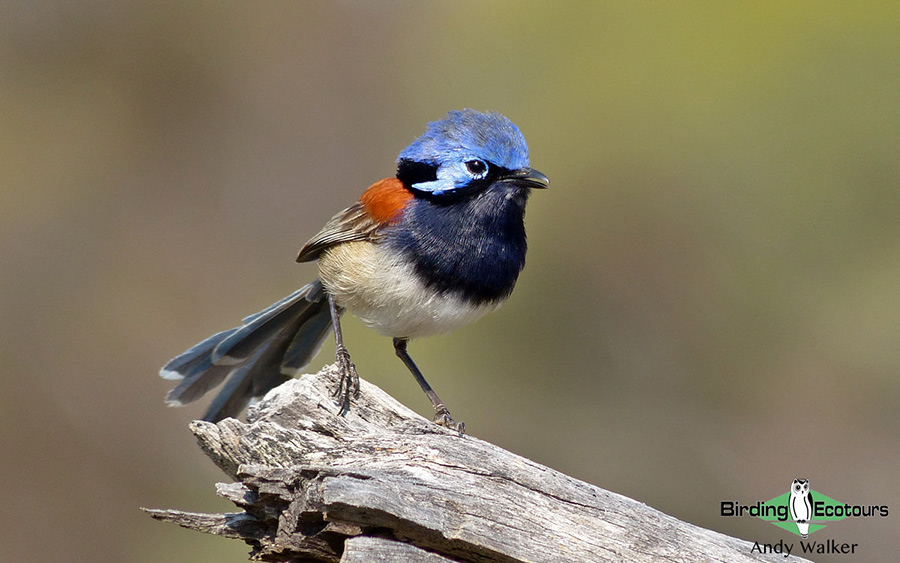 Blue-breasted Fairywren is one of our targets on this trip.
Blue-breasted Fairywren is one of our targets on this trip.
Local endemic bird species that we will be focusing our attention on during the tour include Carnaby’s (Short-billed) and Baudin’s (Long-billed) Black Cockatoos, Western Corella, Red-capped Parrot, Western Rosella, Noisy Scrubbird, Western Bristlebird, Red-winged Fairywren, Western Fieldwren, Western Thornbill, Western Wattlebird, Western Spinebill, Gilbert’s Honeyeater (formerly known as Western White-naped or Swan River Honeyeater), White-breasted Robin, Red-eared Firetail, Black-throated Whipbird, and Western Shriketit. Other species that are near-endemics to the state (and still Australian endemics) also form targets, as they are unlikely to be found on other eastern tours, these include Western Yellow Robin, Rufous Treecreeper, Blue-breasted Fairywren, and Spotted Scrubwren.
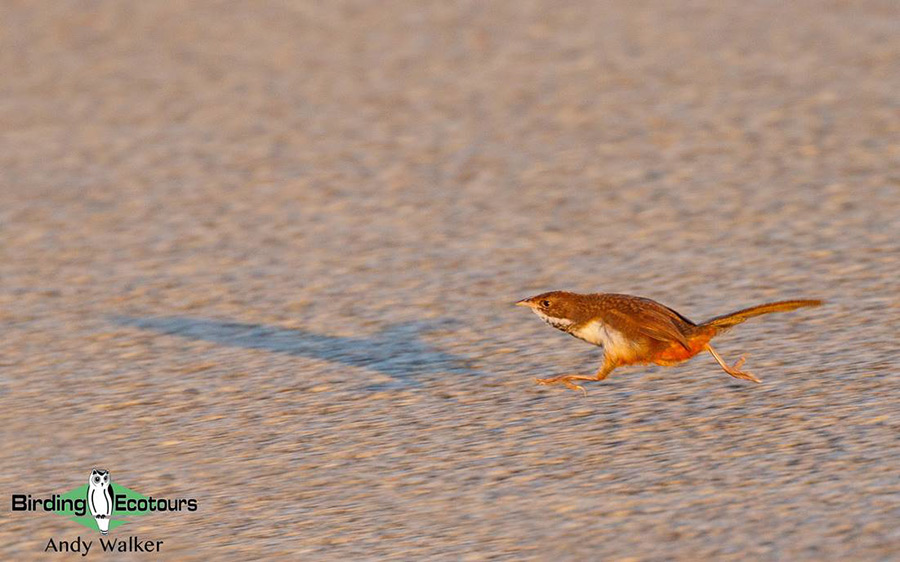
Additional species we will also be looking for include the Australian endemics Malleefowl, Square-tailed Kite, Banded Stilt, Hooded Plover, Rock Parrot, Elegant Parrot, Purple-crowned Lorikeet, Western Whistler, Splendid Fairywren, and the near-endemic Fairy Tern. The isolation of southwestern Australia has led to a high degree of endemism, also at the subspecies level, and we will try to see as many of these as possible in case of potential future splits, such as (Western) Scarlet Robin and others. This tour will prove interesting for those participants who have been birding on the Australian East Coast and/or in Tasmania and are interested in the possibility of some potential future armchair ticks!
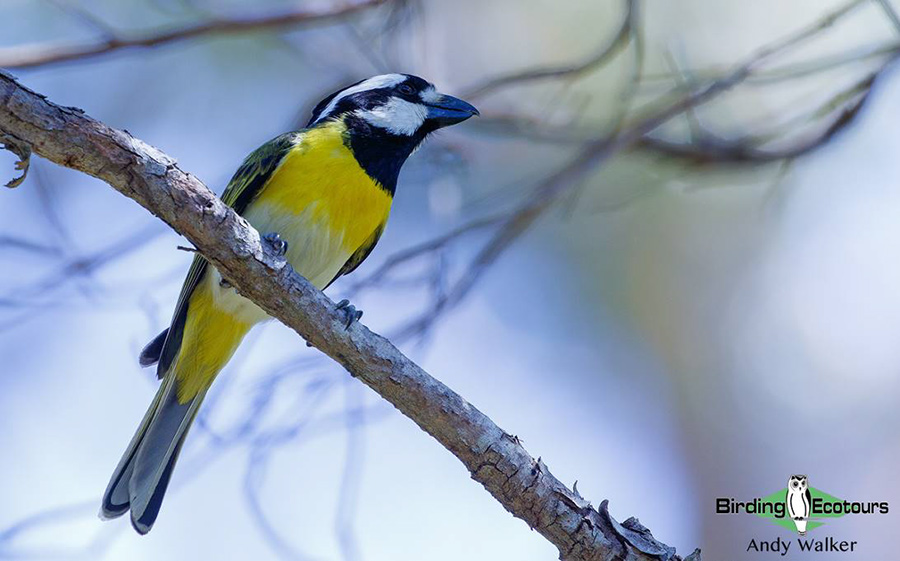
For those wishing to explore Australia further, this tour can be combined with our Birding Tour Australia: Northern Territory – Alice Springs and Uluru Birding Tour and our Birding Tour Australia: Northern Territory – Top End Birding Tour, both of these tours precede this Western Australia birdwatching tour.
Itinerary (9 days/8 nights)
Day 1. Arrival in Perth
Morning arrival into Perth, if not arrived ahead of the tour starting. We will meet in the afternoon and spend the late afternoon birding around Perth, including near to our hotel, adjacent to the famous grounds of the Kings Park and Botanical Gardens, within the city. If we have time, we will take a walk into the park, where we will hope to connect with the first of the southwestern endemics, Western Spinebill and Western Wattlebird, as well as more widespread White-cheeked, New Holland, and Singing Honeyeaters and the huge and ever-vocal Red Wattlebird. Carnaby’s Black Cockatoo could be present, feeding in the pine trees, and we will likely find Little Corella, Australian Ringneck, Laughing Dove (introduced from Africa/India), and Rainbow Lorikeet and Laughing Kookaburra (both introduced from eastern Australia). Passerines here may include Australia’s smallest bird, the tiny Weebill, Australian Reed Warbler, and Little Grassbird, while waterbirds may include the beautiful Nankeen Night Heron and the stately Black Swan. We may also visit other sites within the city depending on local flowering conditions and time available.
Overnight: Perth
Day 2. Perth to Dryandra Woodland
We will likely spend the early morning birding around Perth, seeing some of the above species and others. If tidal conditions allow, we may find Red-necked Stint, Sharp-tailed and Curlew Sandpipers, Great and Red Knots, and Pacific Golden and Grey Plovers, among others. We will also check out some of the lakes in and around the city before we head south. The waterbodies here may harbor a late Freckled Duck if we are very lucky but other species likely include Hardhead, Blue-billed Duck, and Hoary-headed Grebe. Lakeside vegetation may hold Little Grassbird, Australian Reed Warbler, Grey Fantail and Spotless Crake. We will also keep our eyes peeled skywards for any raptors that may be overhead.
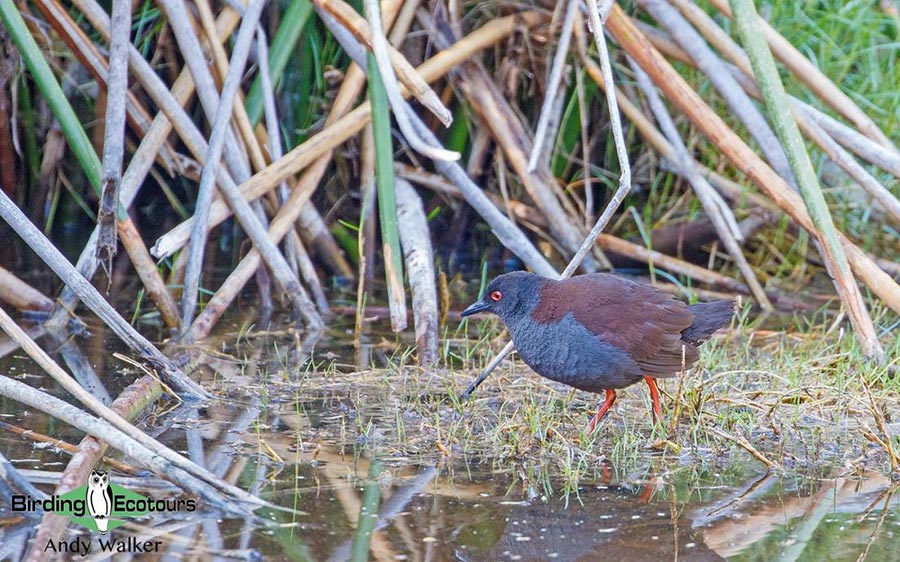
After a late breakfast we will leave Perth and head south towards the Dryandra Woodland area, keeping a look out for Baudin’s Black and Red-tailed Black Cockatoos along the way. After lunch we will check in to our accommodation for the next couple of nights and then head out for an afternoon birding in the local vicinity. This is one of the prime birding sites in the region, so we want to do it justice over the next couple of days.
Overnight: Narrogin
Day 3. Full day at Dryandra Woodland
The woodland consists of an interesting mix of Eucalyptus (jarrah, wandoo, and marri), with a good native shrub layer. We will spend the full day in and around the woodland and will look for some of the area’s specialties, such as Western Yellow Robin, Rufous Treecreeper, Western Whistler, Blue-breasted Fairywren, Western Thornbill, Spotted Scrubwren, and Western Shriketit. We will also look for ‘the’ special mammal found at Dryandra – the rare Numbat.
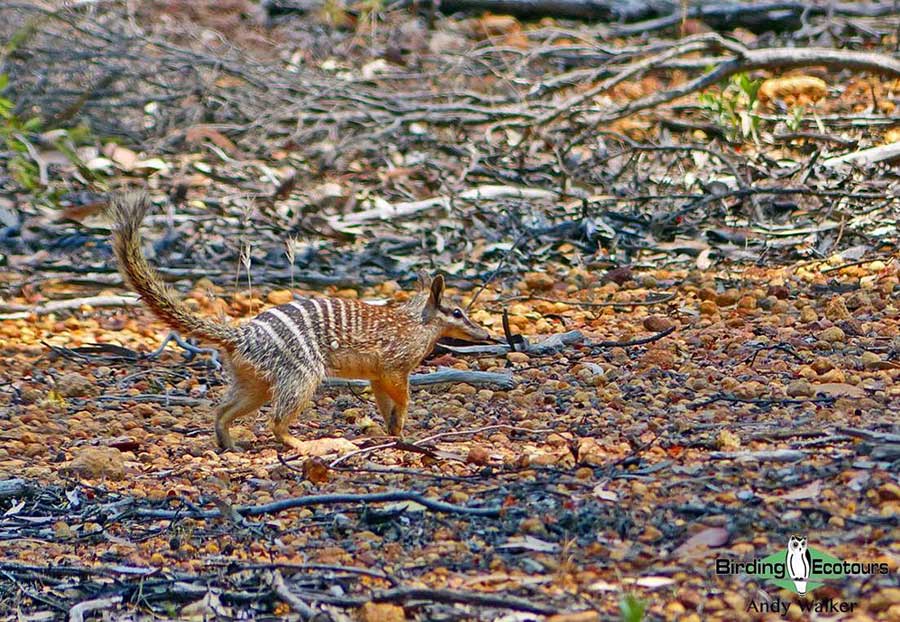
There are plenty of birds to look for around the huge woodland, and we will focus on finding the above birds and other exciting species such as Painted Buttonquail, Wedge-tailed Eagle, Brown Goshawk, Carnaby’s Black Cockatoo, Red-capped Parrot, Western Rosella, Regent Parrot, Elegant Parrot, Brush Bronzewing, Black-faced Cuckooshrike, Western Spinebill, and Tawny-crowned, Yellow-plumed, Brown, Brown-headed, White-cheeked, New Holland, White-eared, and Gilbert’s Honeyeaters, Restless Flycatcher, and Splendid Fairywren.
Overnight: Narrogin
Day 4. Dryandra Woodland to Stirling Range National Park
We will spend the morning back in Dryandra Woodland or another nearby interesting site, focusing on finding the aforementioned species and others that we may still be looking for, or want to see again after our last couple of days.
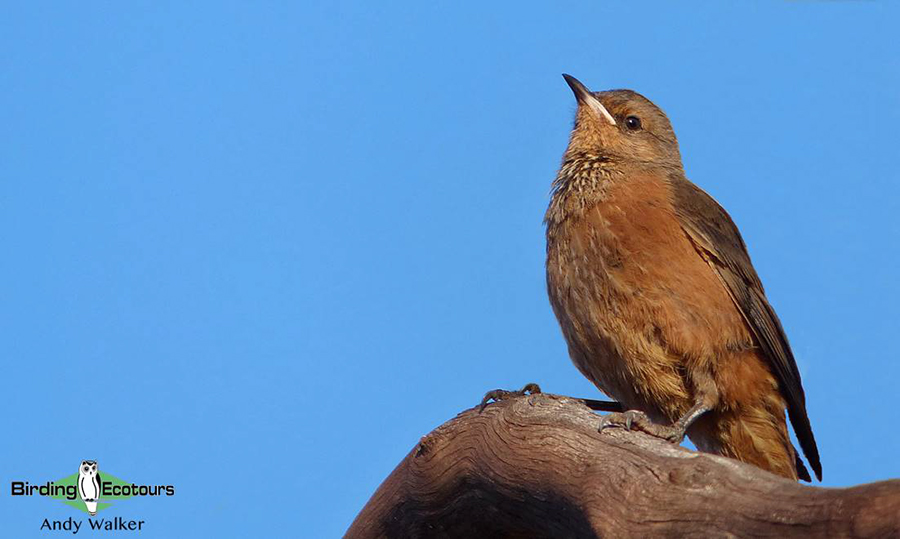
As the day progresses, we will continue south to the Stirling Range National Park, an area renowned for its impressive flora and pretty landscape, as well as plenty of avian targets. While here we will search for Black-throated Whipbird, Southern Scrub Robin, Western Spinebill, Gilbert’s and Purple-gaped Honeyeaters, Western Yellow Robin, Blue-breasted Fairywren, and Western Fieldwren.
Overnight: Amelup
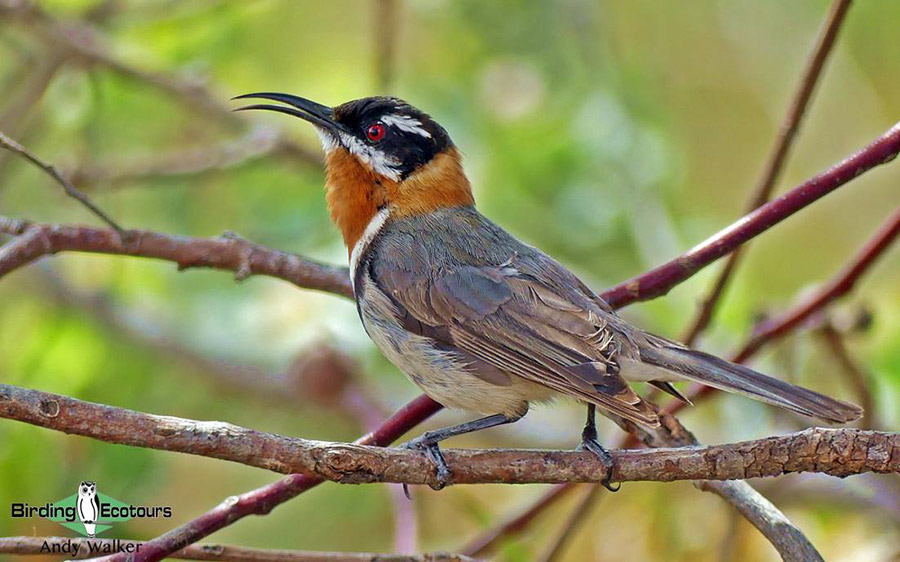
Day 5. Stirling Range National Park to Cheynes Beach
We will spend the morning birding at Sterling Range, seeking out those species referred to above but also many others, such as Square-tailed Kite, Spotted Harrier, Little Eagle, Wedge-tailed Eagle, Peregrine Falcon, Elegant Parrot, Regent Parrot, Rufous Treecreeper, Southern Emu-wren, Red-winged Fairywren, White-breasted Robin, (Western) Scarlet Robin, Western Thornbill, Western Shriketit, and Red-eared Firetail.
After our birding session here, we will travel down to the south coast township of Cheynes Beach, along the way looking out for interesting species such as White-necked Heron, Banded Stilt, and other interesting shorebirds/waders. Cheynes Beach is home to some great (and very difficult) birds, and we will start looking for these as soon as possible after our arrival and check in for our two night stay here.
Overnight: Cheynes Beach
Day 6. Full day at Cheynes Beach
A full day birding the Cheynes Beach area for three of Australia’s toughest, most skulking birds: Noisy Scrubbird, Western Bristlebird, and Black-throated Whipbird (a different subspecies from that at Stirling Ranges and a much talked-about potential further future split). These birds are difficult to see, but we will put all of our effort into securing views of them all during the course of the day.
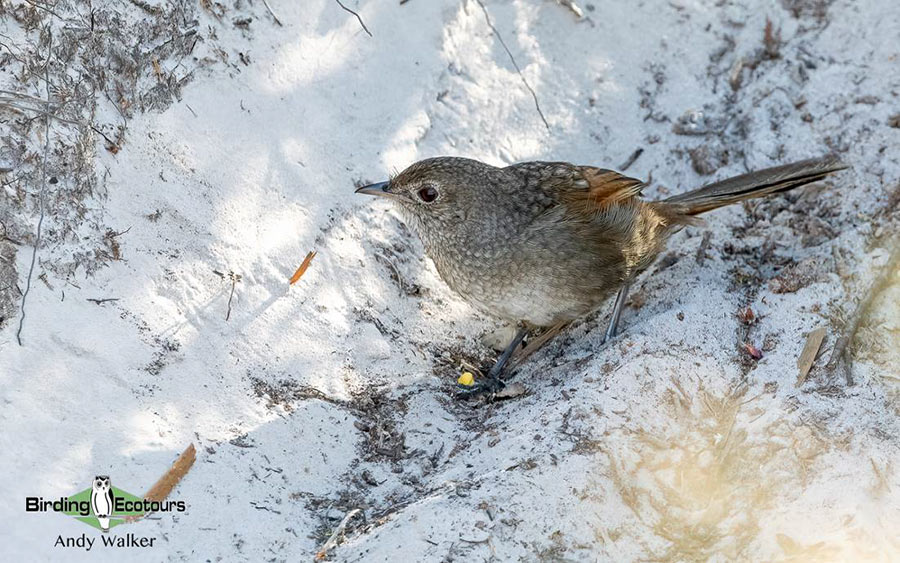
There are also plenty of other species to look for in the area, such as Wedge-tailed Eagle, Black-shouldered Kite, Spotted Harrier, Carnaby’s Black Cockatoo, Purple-crowned Lorikeet, Fan-tailed Cuckoo, Brush Bronzewing, Southern Emu-wren, Red-winged Fairywren, Spotted Scrubwren, Inland Thornbill, White-cheeked Honeyeater, New Holland Honeyeater, White-breasted Robin, Dusky Woodswallow, and Red-eared Firetail.
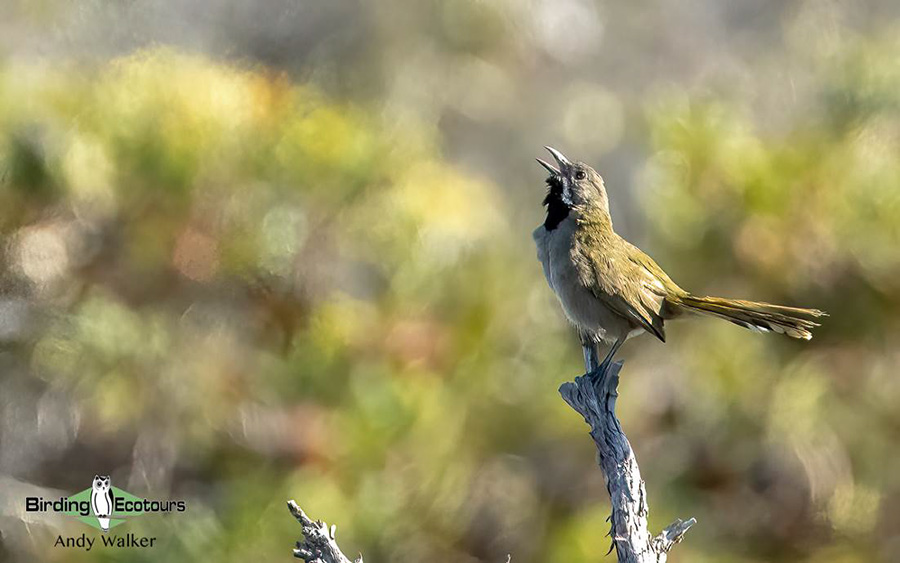
Weather permitting, at night we will look and listen for Tawny Frogmouth, Australian Boobook, and Spotted Nightjar, as well as the area’s nocturnal creatures such as Quokka, Western Ringtail Possum, the tiny Honey Possum (sometimes possible during the day too – they are tiny!), Western Brush Wallaby, and Southern Brown Bandicoot.
Overnight: Cheynes Beach
Day 7. Cheynes Beach to Augusta
We will spend the early morning birding around Cheynes Beach again, enjoying views of some of the above species and mopping up any others we may still want to try and see. We will then make our way west along the spectacularly forested coast with giant red tingle and karri trees towards Augusta. With a stop at Lake Muir Nature Reserve along the way we may find a selection of interesting wildfowl and waders (very much depending on water levels), such as Banded Stilt, Eurasian Coot, Yellow-billed Spoonbill, White-faced Heron, Blue-billed Duck, Freckled Duck, and Chestnut Teal. More secretive species around the lake shore include Spotless Crake, Black-backed Bittern, and Australasian Bittern.
Regardless of water levels, the woodland surrounding the lake is home to a population of Western Corella, known as ‘Muir’s Corella’, which is an endemic and isolated subspecies and worth looking for. Other birds possible here include Emu, Carnaby’s, Baudin’s, and Red-tailed Black Cockatoos, Western Rosella, Australian Ringneck, Brown Quail, Square-tailed Kite, Western Spinebill, Gilbert’s Honeyeater, Southern Emu-wren, White-winged Triller, Restless Flycatcher, Western Yellow Robin, (Western) Scarlet Robin, and Spotted Pardalote. We will arrive in Augusta in time to freshen up before dinner.
Overnight: Augusta
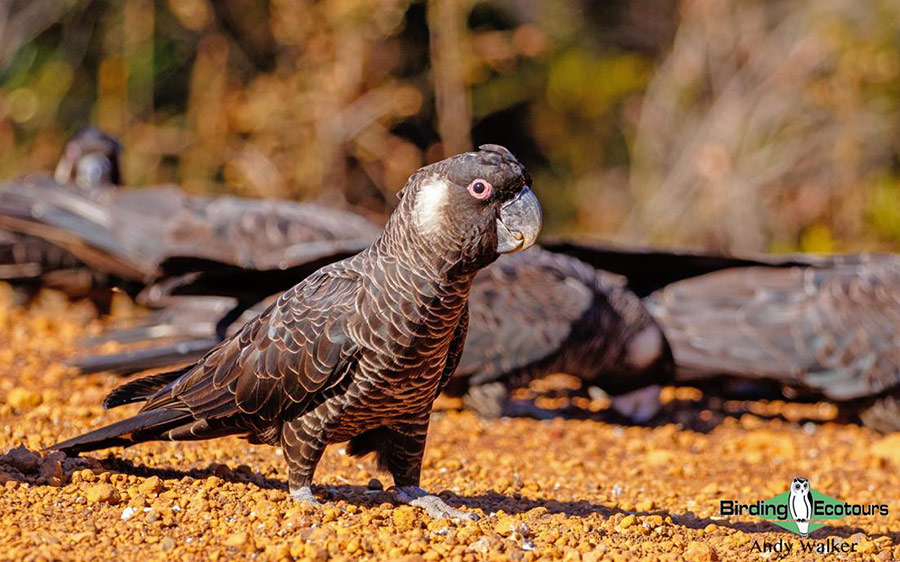
Day 8. Augusta to Busselton
The morning will be spent birding around the rugged coastline of the Cape Leeuwin area, pretty much the most southwesterly point of this huge continent-country where the Indian Ocean meets the Southern Ocean. We will look for seabirds here, such as Bridled Tern, Fairy Tern, Flesh-footed, Hutton’s, and Little Shearwaters, Southern Giant and Northern Giant Petrels, and Indian Yellow-nosed, Black-browed, and Shy Albatrosses. Much depends on what the weather is doing as to what is possible here over the water on any given day.
Along the coast we will look for Sooty and Pied Oystercatchers, Hooded Plover, Grey-tailed Tattler, Far Eastern Curlew, Pacific Reef Heron, Rock Parrot, Southern Emu-wren, and Splendid Fairywren.
After birding here, we will slowly wind our way up the coast, checking our areas of Banksia, jarrah, and marri woodland, with the hopes of seeing more black cockatoos, and Western Shriketit. We will stop in the picturesque Margaret River for lunch and will arrive in the Busselton area in the afternoon for the final night of the tour.
Overnight: Busselton
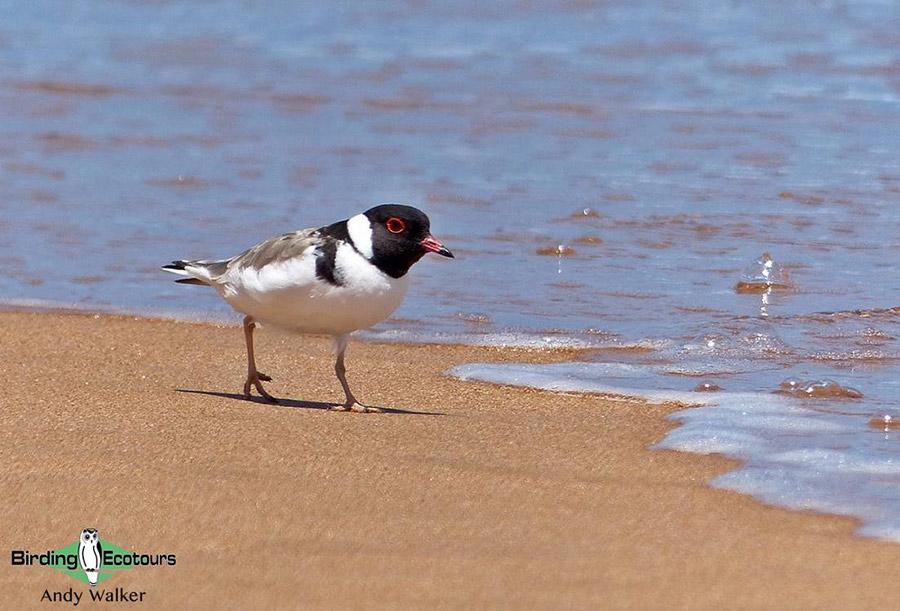
Day 9. Busselton to Perth, departure
Our final morning will be spent checking out some areas around Busselton where we often find interesting shorebirds and waterfowl. We will then commence the return journey back to Perth keeping our eyes peeled for anything interesting we may still want to see.
We will arrive in Perth mid-afternoon where the tour will conclude in time for an evening flight to your next destination.
Overnight: Not included
Please note that the itinerary cannot be guaranteed as it is only a rough guide and can be changed (usually slightly) due to factors such as availability of accommodation, updated information on the state of accommodation, roads, or birding sites, the discretion of the guides and other factors. In addition, we sometimes have to use a different international guide from the one advertised due to tour scheduling.
Download ItineraryWestern Australia: Southwest Specialties Trip Report, October 2023
12 – 20 OCTOBER 2023
By Andy Walker
DOWNLOAD TRIP REPORT
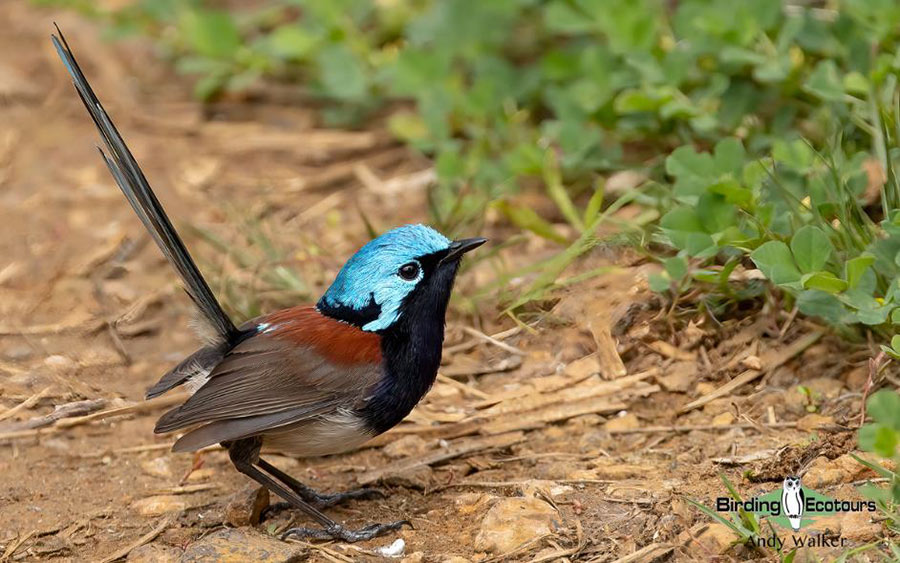
All fairywrens are stunning little birds, the Red-winged Fairywren is no different and is only found in the extreme southwest of Australia. This makes it a big target on our Western Australia bird tour and is always a popular bird, given how beautiful it is.
Overview
This birding tour of Western Australia started in Perth on the 12th of October 2023 and ended back there on the 20th of October 2023. The tour focused on the endemic birds of Southwest Australia, as well as a great number of more widespread Australian endemic birds. During this Western Australia bird tour we birded at Lake Monger Reserve, Herdsman Lake, Foxes Lair Nature Reserve, Dryandra Woodland, Stirling Range National Park, Cheynes Beach, Lake Muir, Cape Leeuwin, Margaret River, Busselton, and Nairns.
We recorded 154 bird species on this Western Australia birdwatching tour, (two of these were heard only). Some of the highlights seen included Noisy Scrubbird, Western Bristlebird, Black-throated Whipbird, Carnaby’s Black Cockatoo, Baudin’s Black Cockatoo, Western Corella, Western Rosella, Red-capped Parrot, Regent Parrot, Rock Parrot, Elegant Parrot, Purple-crowned Lorikeet, Wedge-tailed Eagle, Square-tailed Kite, Australian Hobby, Red-winged Fairywren, Blue-breasted Fairywren, Splendid Fairywren, Southern Emu-wren, Spotted Scrubwren, Western Thornbill, Western Gerygone, Western Fieldwren, Western Spinebill, Gilbert’s Honeyeater, Western Shriketit, White-breasted Robin, Western Yellow Robin, Scarlet Robin, Rufous Treecreeper, Western Whistler, Hooded Dotterel, and Banded Lapwing. In addition to the incredible birds seen, we also found a great selection of other animals, such as Numbat, Short-beaked Echidna, Western Grey Kangaroo, Southern Right Whale, Dugite, (Southwestern) Carpet Python, and several other reptiles. Bird and animal lists for this Western Australia birding tour follow the report.
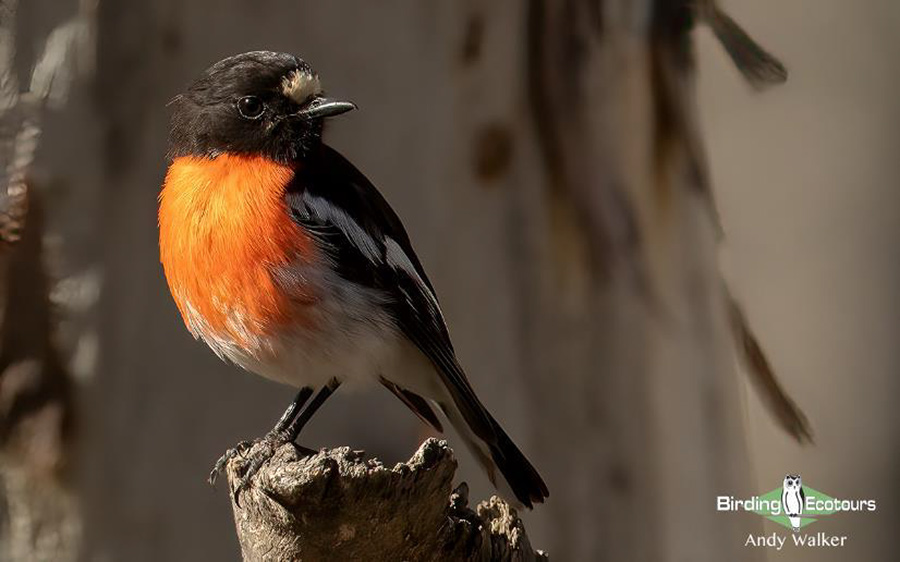
During our Western Australia birding tour, we focused on the endemic species and subspecies found in the region, such as the regionally endemic and geographically isolated campbelli subspecies of Scarlet Robin, a potential future split.
Detailed Report
Day 1, 12th October 2023. Arrival in Perth
We arrived in Perth in the late afternoon and had a group welcome meal in the evening, discussing the plans for the coming week of birding in the bird-filled southwest of Australia.
Day 2, 13th October 2023. Birding Perth and travel to Narrogin
We spent the morning birding at a couple of sites in Perth city. Our first stop, at Lake Monger Reserve, gave us lots of waterfowl, including Musk Duck, Blue-billed Duck, Hardhead, Pink-eared Duck, Hoary-headed Grebe, Eurasian Coot, Dusky Moorhen, Australian Pelican, Black Swan, and Little Black Cormorant. In the vegetation surrounding the lake we noted Straw-necked Ibis, Australian Raven, Willie Wagtail, Little Corella, Rainbow Lorikeet, Red Wattlebird, Brown Honeyeater, and Australian Reed Warbler.
After our birding at Lake Monger Reserve, we moved the short distance to nearby Herdsman Lake, where we had excellent looks at stunning breeding plumage Great Crested Grebes and Australasian Grebes. Additionally, we had very close looks at Pink-eared Duck, and good views of Australian Shoveler, Grey Teal, Pacific Black Duck, Australian Pelican, Australasian Swamphen, Little Egret, Great Egret, Australian White Ibis, Glossy Ibis, Swamp Harrier, Whistling Kite, and Osprey. Meanwhile, Sacred Kingfisher, Australian Reed Warbler, Silvereye, Singing Honeyeater, Australian Magpie, and Little Grassbird were all seen fleetingly. One of the highlights of our birding at Herdsman Lake was finding a family group of roosting Tawny Frogmouths, which showed wonderfully – an early tour highlight, for sure!
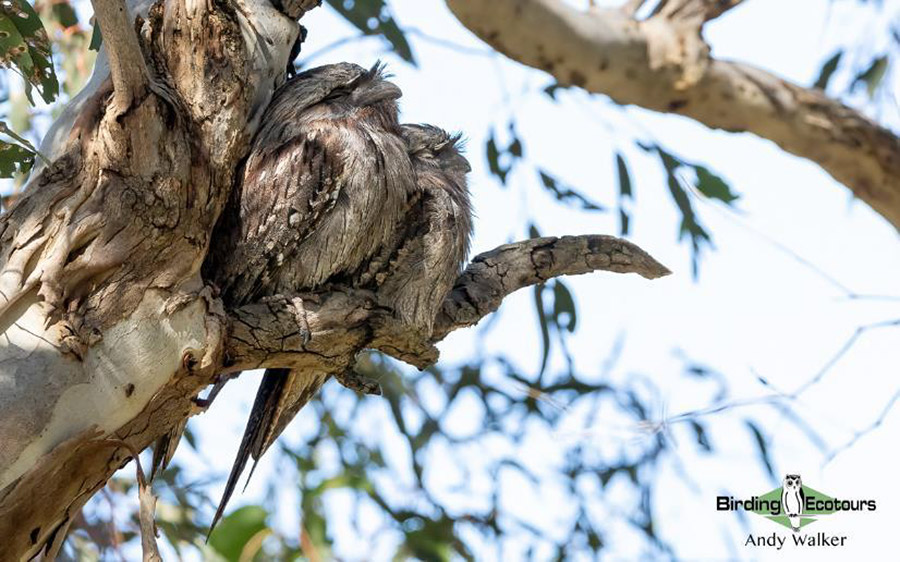
Tawny Frogmouth,showing how well camouflaged they can be, was a great start to the tour!
We left Perth in the late morning and made our way to Narrogin for our two-night stay. Along the way we made a lunch stop at the village of Wandering, where we found Nankeen Kestrel, Australian Ringneck, a stunning male Western Rosella, Western Gerygone, Grey Fantail, and Tree Martin.
After a brief break to check in at our B&B we visited Foxes Lair Nature Reserve, right on the edge of Narrogin, here we found a pair of Square-tailed Kites that showed incredibly well in the beautiful late afternoon sunlight. We then also had good looks at the tiny Weebill, Elegant Parrot, Australian Ringneck, Red-capped Parrot, and Gilbert’s Honeyeater, as well as a stunning male Scarlet Robin, which was glowing in the last rays of the sun.
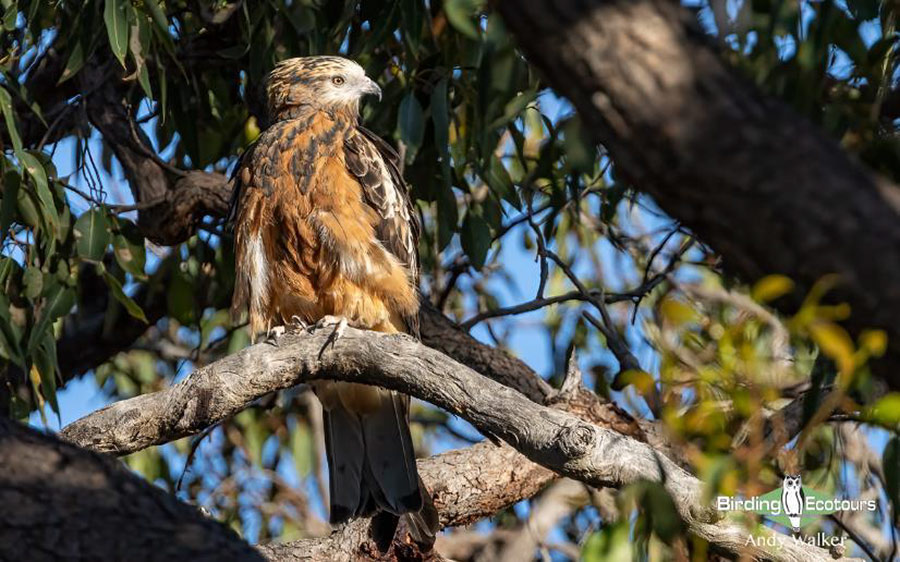
We enjoyed some excellent views of the gorgeous Square-tailed Kite in the late afternoon glow.
Day 3, 14th October 2023. Birding Dryandra Woodland
We spent our morning birding session exploring Dryandra Woodland. As soon as we arrived in the woodland we heard the distinctive high-pitched call of Purple-crowned Lorikeet. We set off to get into a better position to look for them and soon thereafter we were enjoying good views of these attractive small lorikeets. While watching the lorikeets we also got lots of other target species come into our view, such as Carnaby’s Black Cockatoo, Western Yellow Robin, Rufous Treecreeper, Western Whistler, Yellow-plumed Honeyeater, Brown-headed Honeyeater, Gilbert’s Honeyeater, Varied (Black-capped) Sittella, Striated Pardalote, Spotted Scrubwren, Inland Thornbill, and Shining Bronze Cuckoo. Both Collared Sparrowhawk and Peregrine Falcon were noted overhead, causing a bit of alarm amongst the other birds!

An attractive male Blue-breasted Fairywren gave some close views.
We moved deeper into the woodland, finding our first Shingleback Lizard and Western Grey Kangaroos of the tour. Then a few more interesting bird species came our way, including Bush Stone-curlew (a pair with a young baby), Blue-breasted Fairywren, Western Thornbill, Western Gerygone, Tree Martin, Grey Shrikethrush, Rufous Whistler, Jacky-winter, Grey Currawong, Australian Magpie, Australian Raven, and Rainbow Bee-eater. Here, Wedge-tailed Eagle and Brown Goshawk were overhead too.

While birding at Dryandra Woodland, we had incredible close looks at several Carnaby’s Black Cockatoos as they came to a waterhole to drink.
After lunch and a siesta, we went back into Dryandra Woodland for an afternoon birding session. We saw many of the birds listed above, with the addition of a couple of species and improved looks at others, including Western Spinebill and Carnaby’s Black Cockatoo. In addition to the great birds, we also saw the Endangered (IUCN) Numbat (for some people in the group), Short-beaked Echidna, lots of Western Grey Kangaroos, (Gould’s) Sand Goanna, and two snakes, a Dugite and a (Southwestern) Carpet Python.
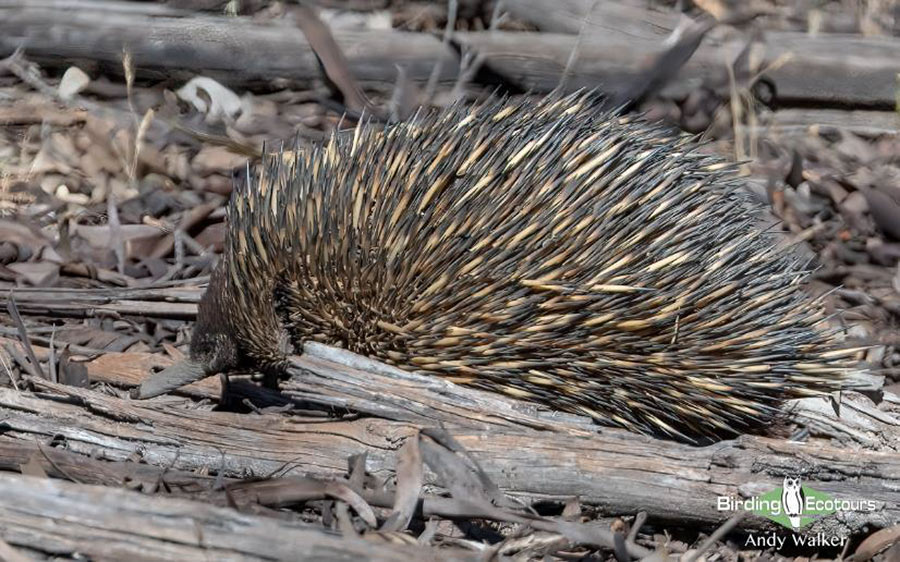
It’s always exciting to see one of Australia’s “strange” animals, and Short-beaked Echidna certainly ticked that box!
Day 4, 15th October 2023. Birding Dryandra Woodland and travel to Stirling Range National Park
We headed back to Dryandra Woodland in the morning (finding a pair of Banded Lapwings along the way), and what a great morning we had. We drove some roads around the woodland and found another Numbat, this one showed much better than the one we’d briefly seen the previous day, and everyone managed to see this one well. We also enjoyed watching a mother Western Grey Kangaroo with a joey in her pouch, and we had further looks at (Gould’s) Sand Goanna – a sunbathing individual soaking in the first rays of the day. All very exciting!
After enjoying seeing the Numbat and other critters, we focused on the birds of Dryandra Woodland once again, and had a really enjoyable walk through a patch of the woodland that has served us well on past tours. Today was no exception, and we found one of the big trip targets, the recently split Western Shriketit. We also found Restless Flycatcher, Horsfield’s Bronze Cuckoo, Rufous Treecreeper, Scarlet Robin, Rainbow Bee-eater, Red-capped Parrot, and several pairs of nesting Purple-crowned Lorikeets.

We saw a Numbat foraging for termites while in Dryandra Woodland.
After finishing our birding at Dryandra Woodland, we commenced our journey to Stirling Range National Park. Along the way we found several notable birds, and these included Peregrine Falcon (a perched pair), Nankeen Kestrel, Black-shouldered Kite, Wedge-tailed Eagle, Chestnut Teal (a pair with very young ducklings), Black-fronted Dotterel, White-faced Heron, White-winged Triller, Rufous Songlark, Australian Pipit, and Pallid Cuckoo.
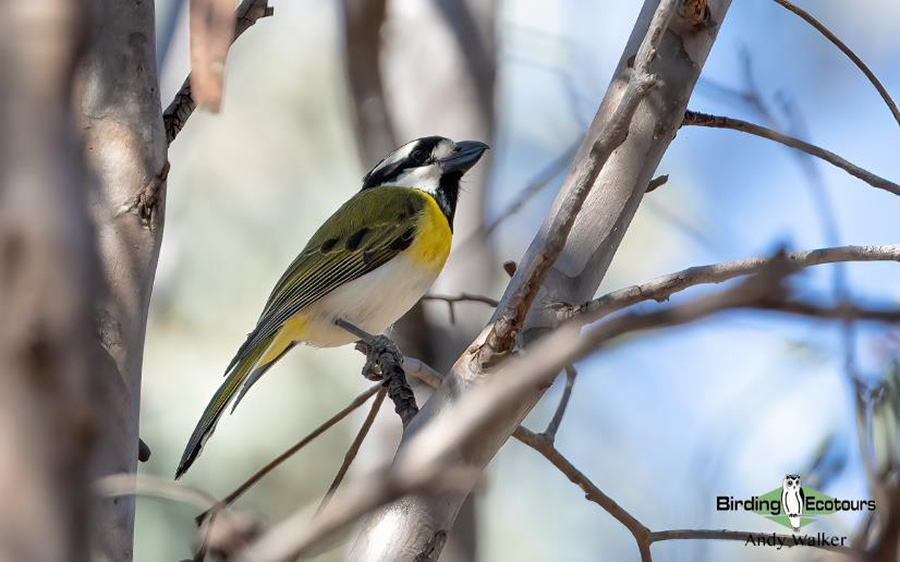
We enjoyed great views of a pair of Western Shriketits in Dryandra Woodland.
Once we arrived at our accommodation at Stirling Range National Park, we took a brief late afternoon walk around the grounds. It was quite late, but we had excellent looks at several Regent Parrots coming into a water bath to drink, along with Gilbert’s Honeyeater, Yellow-plumed Honeyeater, New Holland Honeyeater, and a brief Blue-breasted Fairywren. A fitting end to a great day’s birding in Western Australia.
Day 5, 16th October 2023. Birding Stirling Range National Park and travel to Cheynes Beach
We spent the morning birding around Stirling Range National Park. As we made our way to our first site within the park, we got distracted by several Emus. The first few were quite nervous, but the others, seen a bit later, showed nicely. We also had a flock of Regent Parrots, Rufous Songlark, Brown Falcon, and Grey Butcherbird. On arrival at our main morning birding site, we got several new birds, including Tawny-crowned Honeyeater, White-cheeked Honeyeater, Splendid Fairywren, and Southern Emu-wren. After enjoying these species, we saw the main target, Western Fieldwren, and it showed very well for us. Nankeen Kestrel and Wedge-tailed Eagle were overhead too. As we drove back to get a late breakfast, we found another gorgeous (Southwestern) Carpet Python and our first Western Bluetongue, a lizard full of character!
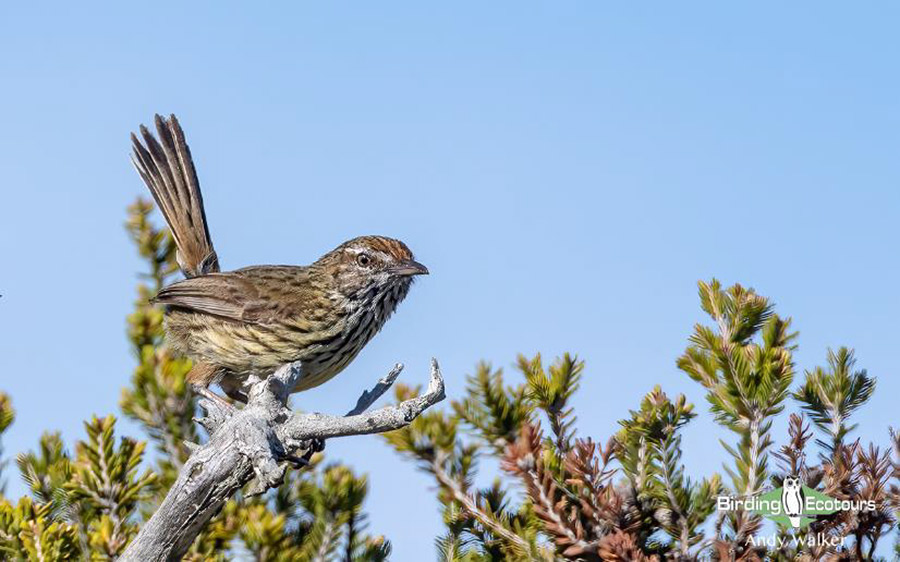
This Western Fieldwren performed brilliantly for us while we birded Stirling Range.
After our late breakfast we visited another section of Stirling Range National Park, where we found Southern Emu-wren, Western Spinebill, Brown Falcon, and more Tawny-crowned Honeyeaters. After this short birding session, we made our journey down to Cheynes Beach. Several stops along the way yielded Red-necked Avocet, Pied Stilt, Silver Gull, Australian Shelduck, Grey Teal, Hoary-headed Grebe, Grey Butcherbird, Yellow-throated Miner, Grey Fantail, and displaying Brown Songlarks.
We took a short walk near our accommodation at Cheynes Beach, where we found several new birds, including White-breasted Robin, Red-winged Fairywren, Brown Quail, Brush Bronzewing, Red-eared Firetail, and our best looks so far of Common Bronzewing and Splendid Fairywren. A King’s Skink looked rather impressive hiding in the undergrowth, our first of many over the coming days, and we had plenty of Western Grey Kangaroos keeping on top of the lawn cutting! Looking out along the beach we found Silver Gull, Greater Crested Tern, Australasian Gannet, Common Sandpiper, and Sooty Oystercatcher.
Day 6, 17th October 2023. Birding Cheynes Beach
We spent the morning walking around the coastal heathland at Cheynes Beach. White-cheeked Honeyeaters were abundant, and many Carnaby’s Black Cockatoos were flying around. We tried to concentrate on finding the three tough species of the region. Noisy Scrubbird was, unsurprisingly, heard but not seen, with a bird calling from deep within some impenetrable heath. Western Bristlebird was the first of the three skulkers to show, a singing bird which then started foraging along a shady section of sand dune. After enjoying the sighting of this one we found Black-throated Whipbird. This bird moved around us giving fleeting and frustrating glimpses, before it then clambered up to a song perch and belted out a burst of its pretty song for us.
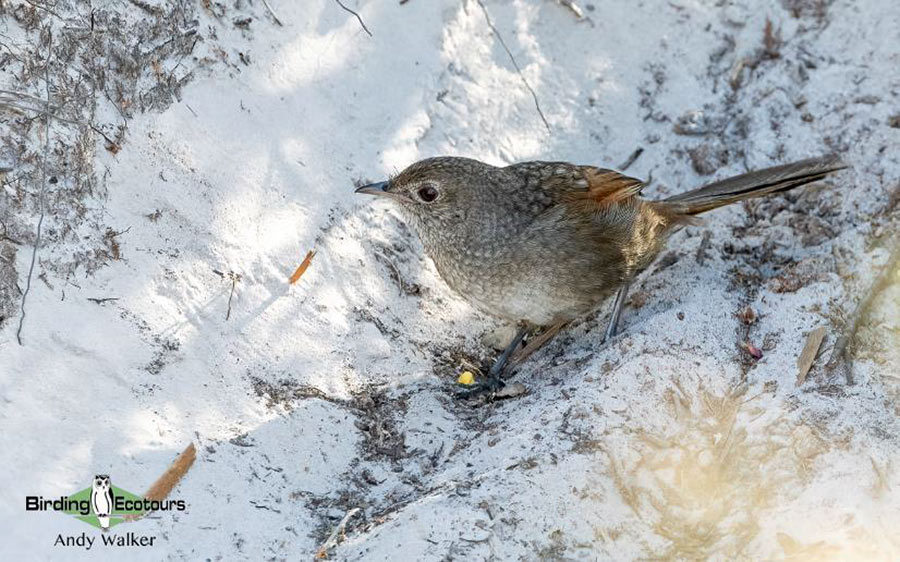
Western Bristlebird was foraging along a shady section of the sand dunes and showed well.
While birding here, we also noted Spotted Scrubwren, Southern Emu-wren, Red-winged Fairywren, New Holland Honeyeater, Red Wattlebird, and Silvereye. Several raptors were moving around the local area, including White-bellied Sea Eagle, Black-shouldered Kite, Collared Sparrowhawk, Brown Falcon, Nankeen Kestrel, and Australian Hobby. The heat started to build considerably and so we took a break during the middle of the day.
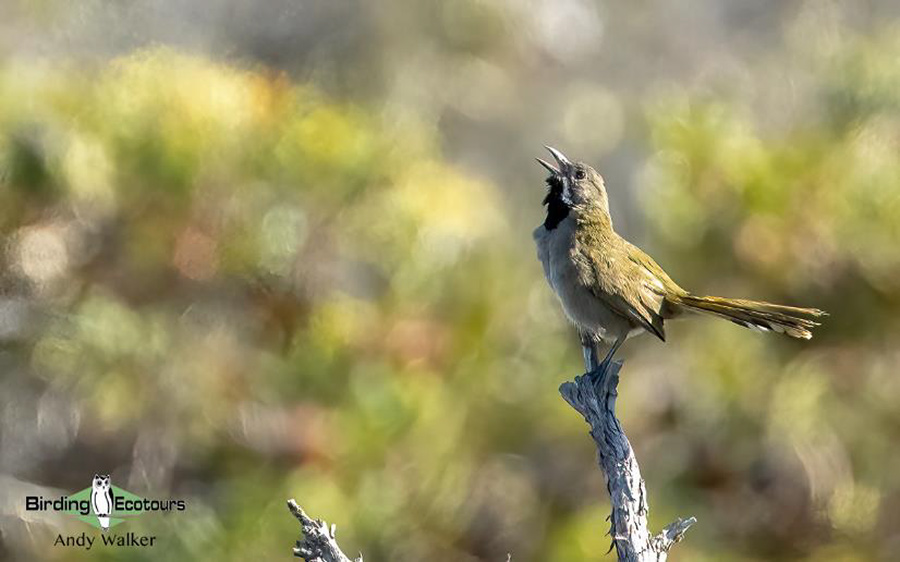
Black-throated Whipbird initially gave us the run-around, but eventually showed nicely as it sang from an exposed perch.
When we met for our afternoon birding session, we were greeted by very strong winds which made birding almost impossible, the sand from the beach and dunes was getting whipped up and blown all around too. It was all rather inhospitable! We took a drive around the village trying to find some shelter from the wind, and some birds to look at, but not a lot was braving the wind. We did however see a rather cute pair of Brown Quails with a very recent golf-ball-sized hatchling in tow. There were not a lot of options with the wind howling, so we parked the van up and waited near a dirt track to see if we could get lucky. After about 90 minutes of waiting, with a very close Brush Bronzewing, a duo of Black-shouldered Kites, several White-breasted Robins, and a pod of Indo-Pacific Bottle-nosed Dolphins doing their best to distract us, we heard a Noisy Scrubbird calling not too far away. After about another 30 minutes of waiting and hoping, all of us had seen this super-skulker and major tour target! We enjoyed another fantastic dinner and a celebratory one at that. The tough trio of Western Bristlebird, Black-throated Whipbird, and Noisy Scrubbird all seen
Day 7, 18th October 2023. Birding Cheynes Beach and travel to Augusta
Today was essentially a travel day interspersed with some birding stops, as we made our way from Cheynes Beach to Augusta, via Albany, Mount Barker, and Lake Muir. A final brief walk near our accommodation at Cheynes Beach gave us a big tour highlight in the form of a mother and calf Southern Right Whale – such a huge animal and they were relatively close inshore too. Here we also had nest-building Red-eared Firetails and Ospreys, as well as a hunting Australian Hobby, and a Fan-tailed Cuckoo.
Moving on to Albany, we were treated to some simply incredible views of a stunning adult male Red-winged Fairywren (see trip report cover image), as well as good views of two Spotless Crakes, Swamp Harrier, Musk Duck, Blue-billed Duck (amazing close views), and Australian Reed Warbler. Here we also saw loads of nesting Straw-necked Ibis and Australian Ibis, as well as our first Little Pied Cormorants of the tour.
As we left the coast behind, we cut inland to Lake Muir, where a few strategic stops resulted in sightings of the Critically Endangered (BirdLife International) Baudin’s Black Cockatoo, Carnaby’s Black Cockatoo, and Western Correla. Here we also saw Emu, plenty of Western Rosellas, Splendid Fairywren, Red-winged Fairywren, Inland Thornbill, Western Whistler, and Spotted Scrubwren. There was water in Lake Muir for a change, and many Black Swans and Australian Shelducks were present. In the late afternoon we continued our journey to Augusta, our base for the night.
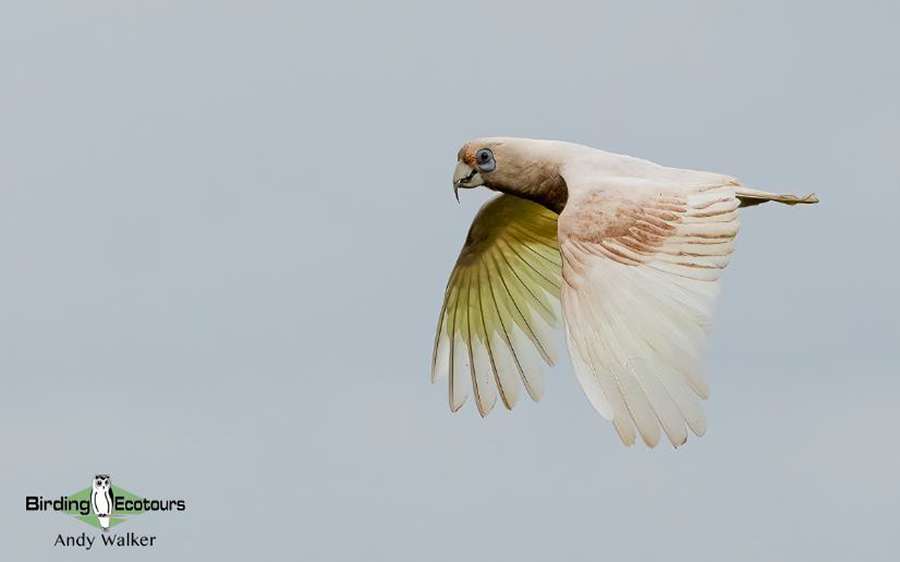
The Western Corellas had been feeding along the shore of Lake Muir and so were rather filthy as they flew right by us!
Day 8, 19th October 2023. Birding Augusta (including Cape Leeuwin) to Busselton
We had an interesting morning at Cape Leeuwin with several hundred BMX bike riders who were starting their cape-to-cape bike race. However, the distractions didn’t prevent us from finding our main target bird of the morning, the habitat-restricted and range-restricted Rock Parrot. A pair of birds gave good close views. We then moved up the coast to the Margaret River area, where a walk on a beach resulted in excellent sightings of three Hooded Dotterels at close range. Other birds noted during the morning at the coast included Australian Pied Cormorant, White-faced Heron, Australasian Gannet, Pacific Gull, Greater Crested Tern, Sooty Oystercatcher, and Osprey.
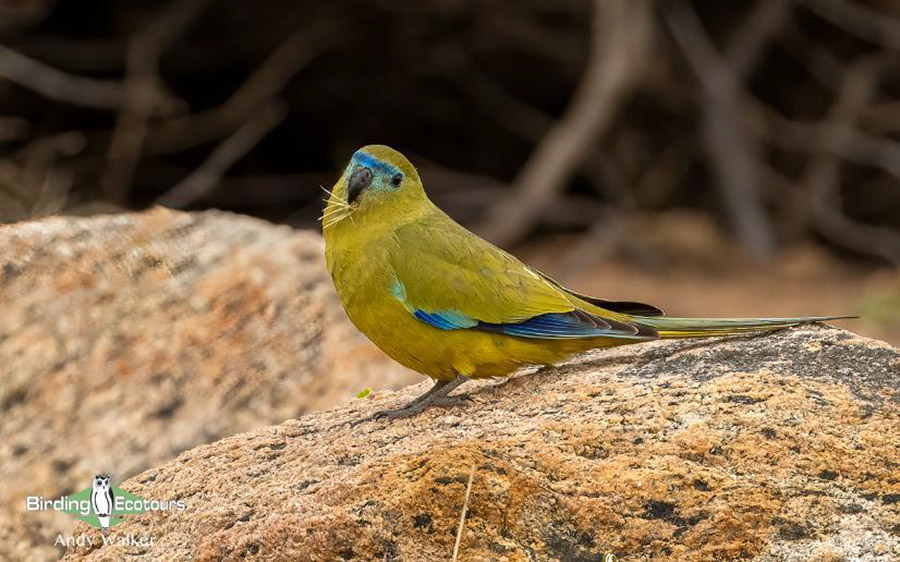
Rock Parrot showed very well at Cape Leeuwin.
After lunch, we continued our journey to Busselton. A short stop in some beautiful Karri and Wandoo woodland near Margaret River gave us a sighting of Common Water Rat (Raikai), Western Whistler, Gilbert’s Honeyeater, and several other forest species. Finally, a stop at an ephemeral wetland near Busselton resulted in good looks at Yellow-billed Spoonbill, Pink-eared Duck, Australasian Swamphen, and several other waterbirds
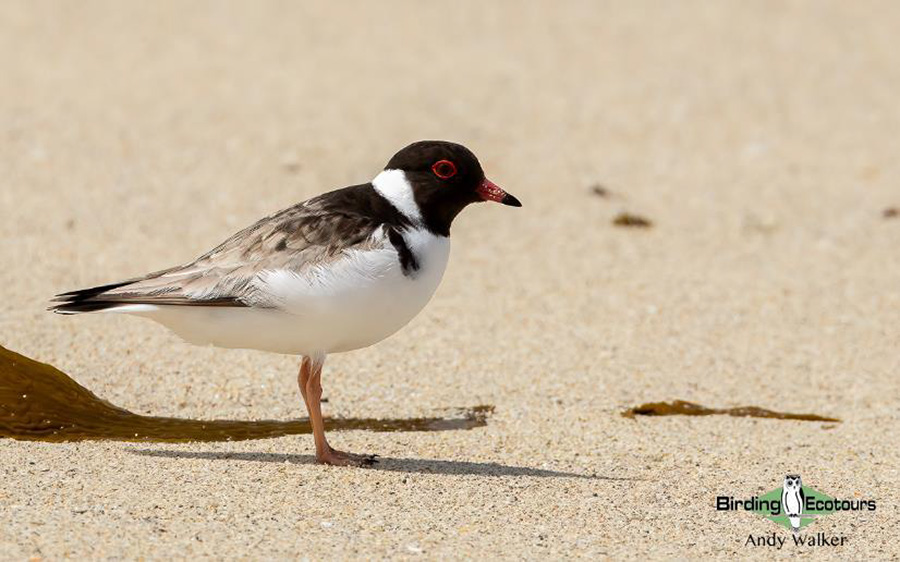
Hooded Dotterel was foraging along a big sandy beach.
Day 9, 20th October 2023. Birding Busselton and travel to Perth for the end of the tour
We spent our final day of the tour traveling from Busselton to Perth, where the tour ended. On the way we spent some time birding at a wetland in Busselton, where we had excellent views of a pair of Musk Ducks in a courtship display, and we saw plenty of other waterfowl, including Australasian Shoveler, Hardhead, Hoary-headed Grebe, Nankeen Night Heron, Dusky Moorhen, Australasian Swamphen, and Yellow-billed Spoonbill. We also had Whistling Kite and a flock of Little Corellas going over. A surprise sighting of a Masked Lapwing was followed by an excellent look at a couple of juvenile Banded Lapwings.
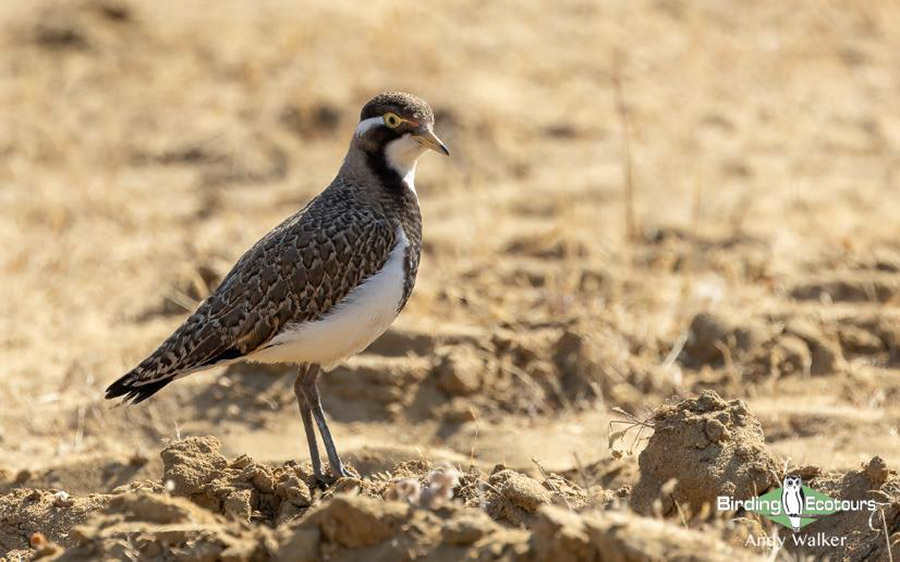
Two juvenile Banded Lapwings showed well for us in Busselton.
Near Perth, we called into a coastal wetland, where we were greeted by a pair of Ospreys at a nest. While scanning the sandflats and estuary we found Fairy Tern, Caspian Tern, Greater Crested Tern, Australian Pied Cormorant, Eastern Cattle Egret, Red-capped Plover, and Pied Oystercatcher. As we checked a pond near the coast, we found plenty of Common Greenshanks, Pied Stilts, and a Buff-banded Rail. After a final lunch, we continued our journey back to Perth, where the tour ended. Lots of great birds were enjoyed on the tour. “Bird of the Trip” was a tough one to pick, with Noisy Scrubbird, Tawny Frogmouth, Red-winged Fairywren, Spotless Crake, Carnaby’s Black Cockatoo, and Red-eared Firetail all being popular.
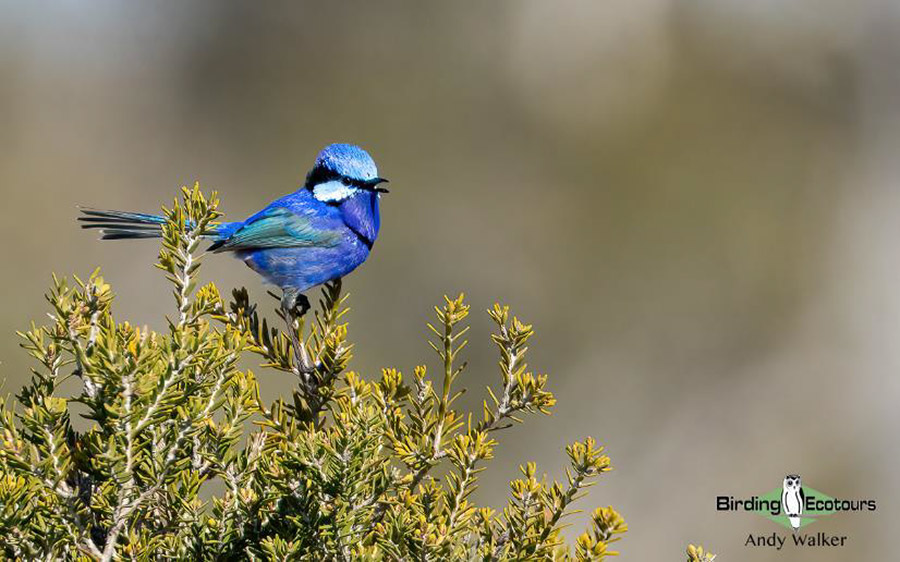
It is hard to look beyond Splendid Fairywren as being one of Australia’s best-looking birds. They are dazzlingly beautiful, and we enjoyed repeated sightings of this popular stunner on our Western Australia birding tour.
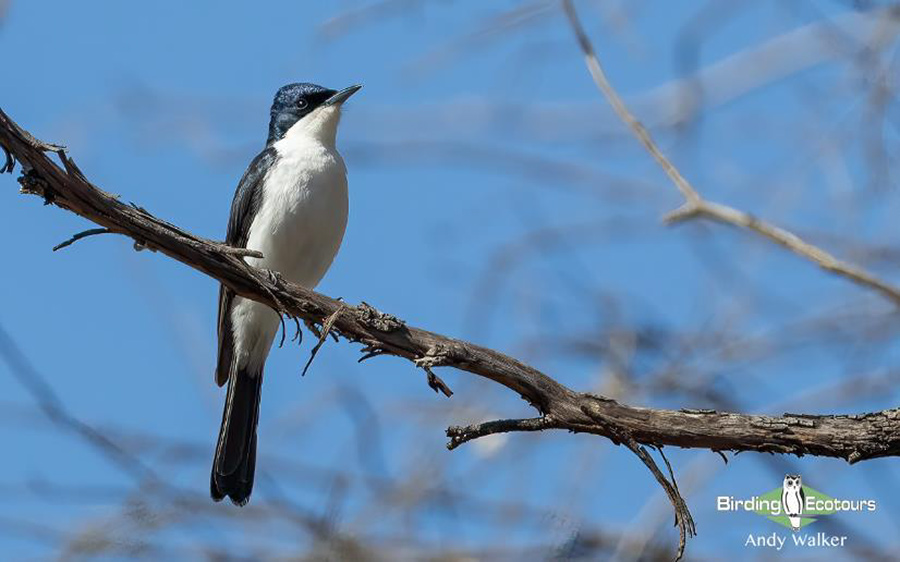
Restless Flycatcher gave us some great views while we were birding at Dryandra Woodland.
Bird List – Following IOC (13.2)
Birds ‘heard only’ are marked with (H) after the common name, all other species were seen. The following notation after species names is used to show conservation status following BirdLife International: CR = Critically Endangered, EN = Endangered, VU = Vulnerable.
| Common Name | Scientific Name |
| Cassowaries, Emu (Casuariidae) | |
| Emu | Dromaius novaehollandiae |
| Ducks, Geese, Swans (Anatidae) | |
| Black Swan | Cygnus atratus |
| Australian Shelduck | Tadorna tadornoides |
| Pink-eared Duck | Malacorhynchus membranaceus |
| Maned Duck | Chenonetta jubata |
| Australasian Shoveler | Spatula rhynchotis |
| Pacific Black Duck | Anas superciliosa |
| Grey Teal | Anas gracilis |
| Chestnut Teal | Anas castanea |
| Hardhead | Aythya australis |
| Blue-billed Duck | Oxyura australis |
| Musk Duck | Biziura lobata |
| Pheasants & Allies (Phasianidae) | |
| Brown Quail | Synoicus ypsilophorus |
| Frogmouths (Podargidae) | |
| Tawny Frogmouth | Podargus strigoides |
| Cuckoos (Cuculidae) | |
| Horsfield’s Bronze Cuckoo | Chrysococcyx basalis |
| Shining Bronze Cuckoo | Chrysococcyx lucidus |
| Pallid Cuckoo | Cacomantis pallidus |
| Fan-tailed Cuckoo | Cacomantis flabelliformis |
| Pigeons, Doves (Columbidae) | |
| Rock Dove | Columba livia |
| Spotted Dove | Spilopelia chinensis |
| Laughing Dove | Spilopelia senegalensis |
| Common Bronzewing | Phaps chalcoptera |
| Brush Bronzewing | Phaps elegans |
| Crested Pigeon | Ocyphaps lophotes |
| Rails, Crakes & Coots (Rallidae) | |
| Buff-banded Rail | Hypotaenidia philippensis |
| Dusky Moorhen | Gallinula tenebrosa |
| Eurasian Coot | Fulica atra |
| Australasian Swamphen | Porphyrio melanotus |
| Spotless Crake | Zapornia tabuensis |
| Grebes (Podicipedidae) | |
| Australasian Grebe | Tachybaptus novaehollandiae |
| Hoary-headed Grebe | Poliocephalus poliocephalus |
| Great Crested Grebe | Podiceps cristatus |
| Stone-curlews, Thick-knees (Burhinidae) | |
| Bush Stone-curlew | Burhinus grallarius |
| Oystercatchers (Haematopodidae) | |
| Pied Oystercatcher | Haematopus longirostris |
| Sooty Oystercatcher | Haematopus fuliginosus |
| Stilts, Avocets (Recurvirostridae) | |
| Pied Stilt | Himantopus leucocephalus |
| Red-necked Avocet | Recurvirostra novaehollandiae |
| Plovers (Charadriidae) | |
| Banded Lapwing | Vanellus tricolor |
| Masked Lapwing | Vanellus miles |
| Red-capped Plover | Charadrius ruficapillus |
| Hooded Dotterel – VU | Thinornis cucullatus |
| Black-fronted Dotterel | Elseyornis melanops |
| Sandpipers, Snipes (Scolopacidae) | |
| Common Sandpiper | Actitis hypoleucos |
| Common Greenshank | Tringa nebularia |
| Gulls, Terns, Skimmers (Laridae) | |
| Silver Gull | Chroicocephalus novaehollandiae |
| Pacific Gull | Larus pacificus |
| Caspian Tern | Hydroprogne caspia |
| Greater Crested Tern | Thalasseus bergii |
| Fairy Tern – VU | Sternula nereis |
| Gannets, Boobies (Sulidae) | |
| Australasian Gannet | Morus serrator |
| Anhingas, Darters (Anhingidae) | |
| Australasian Darter | Anhinga novaehollandiae |
| Cormorants, Shags (Phalacrocoracidae) | |
| Little Pied Cormorant | Microcarbo melanoleucos |
| Australian Pied Cormorant | Phalacrocorax varius |
| Little Black Cormorant | Phalacrocorax sulcirostris |
| Great Cormorant | Phalacrocorax carbo |
| Ibises, Spoonbills (Threskiornithidae) | |
| Australian White Ibis | Threskiornis molucca |
| Straw-necked Ibis | Threskiornis spinicollis |
| Glossy Ibis | Plegadis falcinellus |
| Yellow-billed Spoonbill | Platalea flavipes |
| Herons, Bitterns (Ardeidae) | |
| Nankeen Night Heron | Nycticorax caledonicus |
| Eastern Cattle Egret | Bubulcus coromandus |
| White-necked Heron | Ardea pacifica |
| Great Egret | Ardea alba |
| White-faced Heron | Egretta novaehollandiae |
| Little Egret | Egretta garzetta |
| Pelicans (Pelecanidae) | |
| Australian Pelican | Pelecanus conspicillatus |
| Ospreys (Pandionidae) | |
| Osprey | Pandion haliaetus |
| Kites, Hawks, Eagles (Accipitridae) | |
| Black-shouldered Kite | Elanus axillaris |
| Square-tailed Kite | Lophoictinia isura |
| Wedge-tailed Eagle | Aquila audax |
| Brown Goshawk | Accipiter fasciatus |
| Collared Sparrowhawk | Accipiter cirrocephalus |
| Swamp Harrier | Circus approximans |
| Whistling Kite | Haliastur sphenurus |
| White-bellied Sea Eagle | Icthyophaga leucogaster |
| Kingfishers (Alcedinidae) | |
| Laughing Kookaburra | Dacelo novaeguineae |
| Sacred Kingfisher | Todiramphus sanctus |
| Bee-eaters (Meropidae) | |
| Rainbow Bee-eater | Merops ornatus |
| Caracaras, Falcons (Falconidae) | |
| Nankeen Kestrel | Falco cenchroides |
| Australian Hobby | Falco longipennis |
| Brown Falcon | Falco berigora |
| Peregrine Falcon | Falco peregrinus |
| Cockatoos (Cacatuidae) | |
| Red-tailed Black Cockatoo | Calyptorhynchus banksii |
| Baudin’s Black Cockatoo – CR | Zanda baudinii |
| Carnaby’s Black Cockatoo – EN | Zanda latirostris |
| Galah | Eolophus roseicapilla |
| Western Corella | Cacatua pastinator |
| Little Corella | Cacatua sanguinea |
| Old World Parrots (Psittaculidae) | |
| Regent Parrot | Polytelis anthopeplus |
| Red-capped Parrot | Purpureicephalus spurius |
| Western Rosella | Platycercus icterotis |
| Australian Ringneck | Barnardius zonarius |
| Elegant Parrot | Neophema elegans |
| Rock Parrot | Neophema petrophila |
| Purple-crowned Lorikeet | Parvipsitta porphyrocephala |
| Rainbow Lorikeet | Trichoglossus moluccanus |
| Scrubbirds (Atrichornithidae) | |
| Noisy Scrubbird – EN | Atrichornis clamosus |
| Australasian Treecreepers (Climacteridae) | |
| Rufous Treecreeper | Climacteris rufus |
| Australasian Wrens (Maluridae) | |
| Blue-breasted Fairywren | Malurus pulcherrimus |
| Red-winged Fairywren | Malurus elegans |
| Splendid Fairywren | Malurus splendens |
| Southern Emu-wren | Stipiturus malachurus |
| Honeyeaters (Meliphagidae) | |
| Western Spinebill | Acanthorhynchus superciliosus |
| Tawny-crowned Honeyeater | Gliciphila melanops |
| New Holland Honeyeater | Phylidonyris novaehollandiae |
| White-cheeked Honeyeater | Phylidonyris niger |
| Brown Honeyeater | Lichmera indistincta |
| Brown-headed Honeyeater | Melithreptus brevirostris |
| Gilbert’s Honeyeater | Melithreptus chloropsis |
| Singing Honeyeater | Gavicalis virescens |
| Yellow-plumed Honeyeater | Ptilotula ornata |
| Red Wattlebird | Anthochaera carunculata |
| Yellow-throated Miner | Manorina flavigula |
| Bristlebirds (Dasyornithidae) | |
| Western Bristlebird – EN | Dasyornis longirostris |
| Pardalotes (Pardalotidae) | |
| Spotted Pardalote (H) | Pardalotus punctatus |
| Striated Pardalote | Pardalotus striatus |
| Australasian Warblers (Acanthizidae) | |
| Weebill | Smicrornis brevirostris |
| Western Fieldwren | Calamanthus montanellus |
| Spotted Scrubwren | Sericornis maculatus |
| Western Gerygone | Gerygone fusca |
| Inland Thornbill | Acanthiza apicalis |
| Western Thornbill | Acanthiza inornata |
| Yellow-rumped Thornbill | Acanthiza chrysorrhoa |
| Whipbirds (Psophodidae) | |
| Black-throated Whipbird | Psophodes nigrogularis |
| Woodswallows, Butcherbirds & Allies (Artamidae) | |
| Dusky Woodswallow | Artamus cyanopterus |
| Australian Magpie | Gymnorhina tibicen |
| Grey Butcherbird | Cracticus torquatus |
| Grey Currawong | Strepera versicolor |
| Cuckooshrikes (Campephagidae) | |
| Black-faced Cuckooshrike | Coracina novaehollandiae |
| White-winged Triller | Lalage tricolor |
| Sittellas (Neosittidae) | |
| Varied Sittella | Daphoenositta chrysoptera |
| Shriketits (Falcunculidae) | |
| Western Shriketit | Falcunculus leucogaster |
| Whistlers & Allies (Pachycephalidae) | |
| Western Whistler | Pachycephala fuliginosa |
| Rufous Whistler | Pachycephala rufiventris |
| Grey Shrikethrush | Colluricincla harmonica |
| Fantails (Rhipiduridae) | |
| Willie Wagtail | Rhipidura leucophrys |
| Grey Fantail | Rhipidura albiscapa |
| Monarchs (Monarchidae) | |
| Magpie-lark | Grallina cyanoleuca |
| Restless Flycatcher | Myiagra inquieta |
| Crows, Jays (Corvidae) | |
| Australian Raven | Corvus coronoides |
| Australasian Robins (Petroicidae) | |
| White-breasted Robin | Quoyornis georgianus |
| Western Yellow Robin | Eopsaltria griseogularis |
| Jacky Winter | Microeca fascinans |
| Scarlet Robin | Petroica boodang |
| Swallows, Martins (Hirundinidae) | |
| Welcome Swallow | Hirundo neoxena |
| Tree Martin | Petrochelidon nigricans |
| Reed Warblers & Allies (Acrocephalidae) | |
| Australian Reed Warbler | Acrocephalus australis |
| Grassbirds & Allies (Locustellidae) | |
| Little Grassbird | Poodytes gramineus |
| Brown Songlark | Cincloramphus cruralis |
| Rufous Songlark | Cincloramphus mathewsi |
| White-eyes (Zosteropidae) | |
| Silvereye | Zosterops lateralis |
| Flowerpeckers (Dicaeidae) | |
| Mistletoebird (H) | Dicaeum hirundinaceum |
| Waxbills, Munias & Allies (Estrildidae) | |
| Red-eared Firetail | Stagonopleura oculata |
| Wagtails, Pipits (Motacillidae) | |
| Australian Pipit | Anthus australis |
| Total seen | 152 |
| Total heard only | 2 |
| Total recorded | 154 |
Mammal List
| Common Name | Scientific Name |
| Kangaroos, Wallabies, and Allies (Macropodidae) | |
| Western Grey Kangaroo | Macropus fuliginosus |
| Numbats (Myrmecobiidae) | |
| Numbat | Myrmecobius fasciatus |
| Dasyures (Dasyuridae) | |
| Yellow-footed Antechinus | Antechinus flavipes leucogaster |
| Echidnas (Tachyglossidae) | |
| Short-beaked Echidna | Tachyglossus aculeatus |
| Hares and Rabbits (Leporidae) | |
| European Rabbit | Oryctolagus cuniculus |
| Old World Mice and Rats (Muridae) | |
| Common Water Rat (Rakali) | Hydromys chrysogaster |
| Oceanic Dolphins (Delphinidae) | |
| Indo-Pacific Bottlenose Dolphin | Tursiops aduncus |
| Bowhead and Right Whales (Balaenidae) | |
| Southern Right Whale | Eubalaena australis |
| Total | 8 |
Reptile List
| Common Name | Scientific Name |
| Monitor Lizards (Varanidae) | |
| (Gould’s) Sand Goanna | Varanus gouldii |
| Heath Goanna | Varanus rosenbergi |
| Skinks (Scincidae) | |
| Shingleback Lizard | Tiliqua rugosa |
| Western Bluetongue | Tiliqua occipitalis |
| King’s Skink | Egernia kingii |
| Elapid Snakes (Elapidae) | |
| Dugite | Pseudonaja affinis |
| Pythons (Pythonidae) | |
| (Southwestern) Carpet Python | Morelia spilota imbricata |
| Total | 7 |
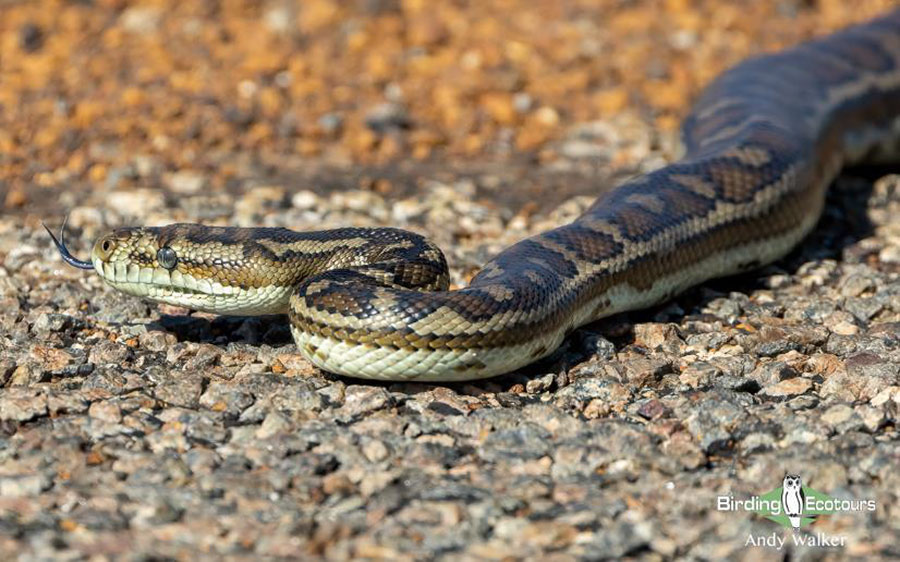
(Southwest) Carpet Python is an attractive snake, we saw two individuals out sunning themselves during the tour.
DOWNLOAD TRIP REPORT
This is a sample trip report. Please email us ([email protected]) for more trip reports from this destination.
Birding Tour Australia: Western Australia – Southwest Specialties
Tour-Specific Information
GENERAL INFORMATION ABOUT AUSTRALIA CAN BE READ HERE
TOUR OUTLINE
This is a comprehensive Western Australia birding tour, yet it is also well-paced, allowing the opportunity to really enjoy the birds of the region. We have a couple of two-night stays along our Western Australian birding route, where we have more time to unpack and focus on the special birds of each area. Western Australia has been cut off from eastern Australia for many years, and as a result, many regionally endemic birds (and rare mammals) exist. Seemingly each year, scientific studies elevate distinct subspecies to full species status – e.g., Western Shriketit is the latest endemic species for the region with the split of the former Crested Shriketit complex into three geographically isolated “new” species. We pay careful attention to all different subspecies on this tour, even if the species may be common on our eastern Australia tour (if you’ve already done that one) because there is a reasonable chance of a future armchair tick!
Our Western Australia bird tour starts and ends in beautiful Perth. We really recommend getting in early for this tour to get used to the time zone and to enjoy what the city has to offer – good food and wine and some excellent parklands for birding. Perth is a long way from anywhere (even other major cities in Australia!) but is serviced by international flights from all around the world, as well as numerous domestic flights from all around Australia.
We will be concentrating on the endemic birds of Western Australia on this Western Australia birdwatching tour; some of these include some excellent parrots, such as Carnaby’s Black Cockatoo, Baudin’s Black Cockatoo, Western Corella, Red-capped Parrot, and Western Rosella. More secretive regionally endemic birds include Noisy Scrubbird, Western Bristlebird, and Black-throated Whipbird. Other top endemic targets on our Western Australia bird tour include Western Spinebill, Gilbert’s Honeyeater, White-breasted Robin, and Red-eared Firetail. Species not likely on many other Australian bird tours (as they mainly occur in a bit of a birdwatcher’s no-mans-land away from Western Australia), include Rufous Treecreeper, Blue-breasted Fairywren, Western Yellow Robin, and Western Whistler – all are stunners too! The tour also offers up chances of some exciting mammals, with one of the main targets being the very rare Numbat. Other interesting mammals can include Western Grey Kangaroo and the tiny Honey Possum. A decent list of reptiles can be expected if spring has sprung and temperatures are increasing. There could also be some interesting flowers on show, particularly orchids, which the Stirling Range is well known for (weather and season depending).
DAILY ACTIVITIES, PHYSICAL REQUIREMENTS, AND TOUR PACE
This Western Australia bird tour goes at a moderate pace, but there are a couple of two-night stays in the itinerary. We will cover quite a bit of ground on our birding circuit of the southwest of Western Australia. This circuit starts and ends in Perth and visits Dryandra Woodland, Stirling Range National Park, Cheynes Beach, Augusta (Cape Leeuwin), and Busselton.
There is quite a bit of driving involved to get between birding areas; these will be broken up by bathroom breaks and lunch/snack stops where possible. Most of the drives are around 2 – 3 hours in duration, but these will become longer with birding/lunch stops added. The longest drive is as we move between Cheynes Beach and Augusta; this is a drive of 4 – 5 hours, depending on traffic and birding stops. We usually buy a picnic lunch and eat this along the way on this day as the route passes through some areas with little provisions but some good birding stops.
The tour is generally considered easy in terms of physical exertion. We tend to make short walks from our vehicle or accommodation in a loop of up to 0.6 – 1.2 miles (1 – 2 kilometers/km), and we may make several of these a day. On a couple of occasions, such as at Cheynes Beach we are likely to make slightly longer walks of 2.5 miles (4 km). Most of the walking we will do will be on mainly flat (sometimes sandy ground), but there are a couple of hills we will walk up/down, particularly while in the Stirling Range area and the Cheynes Beach area. These walks are not considered difficult. We will, of course, take all walks slowly and at birding pace.
We will likely stake out one or two birds, which may require sitting in one place for a few hours (so having some layers will be important in case the temperature is low – see the “Weather” section below). We may look for some nocturnal wildlife at a couple of sites if the weather is suitable.
On some occasions, when we have multiple nights at one location, we will likely take a break for some rest and relaxation during the middle of the day.
TRANSPORTATION
We will use a 12-seater minibus on this Western Australia birdwatching tour. There will be limited baggage space in the vehicle, so please pack as lightly as possible for the tour (including within the seating area).
DOMESTIC FLIGHTS
There are no domestic flights on this Western Australia bird tour.
LUGGAGE
Please pack as lightly as possible for this Western Australia birding tour. A medium, soft-sided, and robust duffle bag is likely to work best for packing in the tour vehicles. You will be expected to load and unload your own bags into and out of vehicles and to/from your rooms.
We recommend a daypack is used to keep items that you wish to use daily when in the vehicle or when birding in the field (such as binoculars, camera, notebook, field guide, personal supply of water, snacks, umbrella, rain jacket, extra layers of clothing, etc.).
ACCOMMODATION
We stay in a very wide range of accommodation on this Western Australia birding tour, including nice city hotels, quaint countryside/rural bed and breakfasts, static caravans, holiday cottages, basic hotels/motels, and more luxurious lodges. The accommodation we use on this bird tour has been selected due to their good locations in terms of birding sites and places to eat (also important when in rural locations!). Most accommodation has ensuite bathrooms. At Stirling Range, we stay in small cottages; each cottage has two private bedrooms with a communal bathroom, kitchen, and dining/lounge area. We will spend one night here. The exact number of cottages we have depends on the final number of tour participants and rooming arrangements. Wi-Fi is available at most places we stay on this tour. Some of the accommodation provides breakfast/meals, and we will eat those there, where suitable. See the “Meals” section below for more.
MEALS
Despite Perth being one of the biggest and most cosmopolitan cities in Australia, once you leave the city behind, it becomes rural very quickly. Breakfasts will be taken at our overnight venues in most instances, though at some locations, such as at Stirling Range, Augusta, and Bussleton, we will use local cafés. Most lunches will be sourced from local bakeries or cafés and either eaten onsite or as we drive between different birding locations. Most dinners will be eaten at pubs or restaurants near our accommodation. On one night, when we stay at Stirling Range Retreat, we will have a picnic dinner sourced along the way. Our accommodation at Cheynes Beach will provide breakfast and dinner for us. Please make sure you have notified us of any dietary restrictions for this tour.
WEATHER
This tour will be occurring during the Western Australian spring; therefore, we can expect a range of temperatures and weather. The average daytime temperature is likely to be 61 degrees Fahrenheit (oF) (16 degrees Centigrade/oC), with highs of 70 oF (21 oC). At night, the temperatures could be in the region of 52 oF (11 oC). It is likely to be warmer inland and cooler by the sea, where southerly airflows can bring colder conditions. There are no notable elevation gains on this tour to impact the temperature. Rainfall could occur at any time on this tour but is more likely in coastal areas.
WHAT TO BRING: CLOTHING AND OTHER ITEMS
The following is a list of useful items to bring on this Western Australia birding tour and should be read in conjunction with the Australia general information document.
- A field guide to the birds of Western Australia. See the general information for our recommendations for this tour.
- Hiking pole or walking stick to help on the tracks and trails. While probably not necessary for everyone, a walking stick is compulsory for anyone who is unsteady walking, as we feel this is a safety issue; we don’t want anyone slipping on the trails or anywhere else. Please discuss with us if you are unsure whether you will need one or not.
- Torch (flashlight) and/or headlamp (headtorch), and spare batteries.
- High-concentration DEET insect repellant, or similar.
- A small personal first aid kit. See the suggested items from the Centers for Disease Control and Prevention (CDC), here.
- Lightweight hiking boots are likely the best footwear for this tour. A set of sandals (flip-flops) and/or trainers would be useful for walking around some of the accommodations but are not suitable for birding time (e.g., consider snake bites, mud, slips, trips, and falls, etc.).
- Quick-drying birding clothes (in suitable colors) are the best for this tour, and a good selection of clothing layers (including sweater/jumper/fleece/coat) are also recommended due to the potential for cool or even cold mornings or days, particularly on the south coast.
- Light rain jacket/poncho (and small umbrella) as rain could fall at any time at any location. Spring in Western Australia could see rain showers or prolonged periods of rain if a weather system moves through.
- A dry bag to keep valuable documents in, such as passports, cell phones, wallets, etc., as well as cameras, if it rains.
Download Australia – Southwest Specialties tour Information
DOWNLOAD AUSTRALIA GENERAL INFORMATION
Andy is a superb guide with a wonderful knowledge of birds and where to find them. He is enthusiastic and keen, great company and a real pleasure to bird with. Our Australian trip was very successful in terms of sightings and also really enjoyable. Andy played a big part in that with his superb organisation, excellent birding skills, easy-going nature and positive attitude. I would happily join Andy on a birding trip again and hope to be able to do so later this year!
Andy Walker was absolutely excellent. Knowledgeable, affable, organized, sense of humor, and attentive to everyone. I would go anywhere with Andy.
Particularly enjoyed the south and southwest coastal regions. Andy is an exceptional guide.

